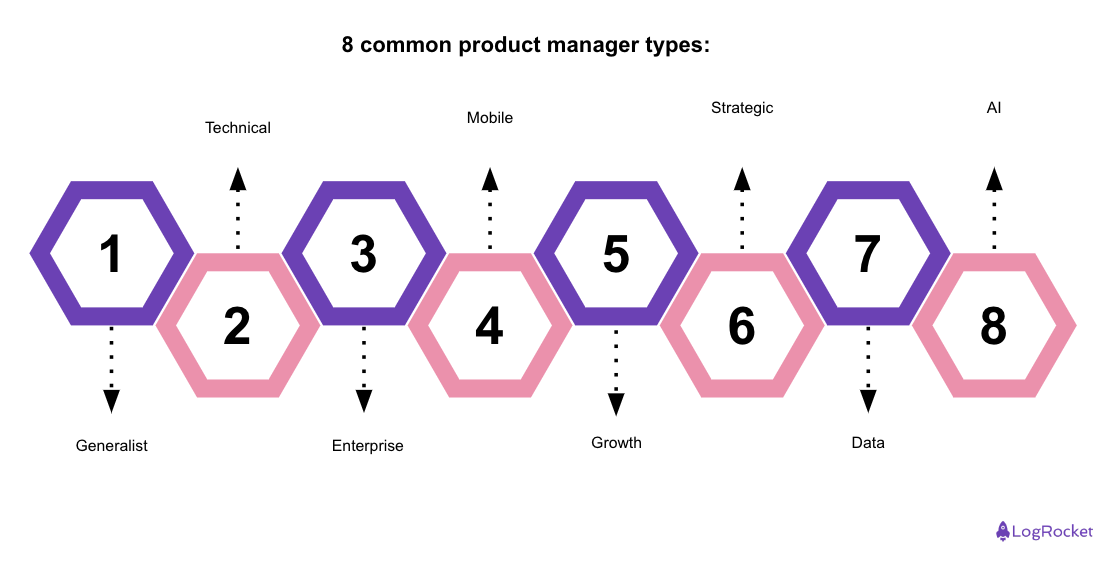Product management can be a lucrative career choice but it isn’t widely known or understood by most people. PMs hail from a wide range of backgrounds such as Marketing, Mathematics, Computer Science, and Business. Recently, PM degrees or programs have even started to emerge.

A quick LinkedIn search for “product manager jobs” results in a plethora of roles with titles that include: Associate Product Manager, Data Product Manager, Growth Product Manager, Senior Product Manager, and more. What do all these variations mean? How does the scope of responsibilities change depending on the specific product role? Where do you even start figuring out which role is right for you?
This article demystifies the rise of specializations in product management, as well as helps guide you in assessing which path may be right for you.
Over the years, friends and family have asked me hundreds of times about what exactly I do. I find it incredibly tough to formulate an answer that makes sense. The role of a product manager historically has been hard to define simply because of the sheer number of hats a product manager wears. PMs are researchers, designers, marketers, project managers, and leaders all rolled into one role.
Now I try to answer this question by drawing parallels to products they use and they can relate to… like a shoe. Someone had the idea of the concept of that shoe, validated the design and user experience, and worked with a team to build and ship the shoe to you. You would call that person a product manager.
Until recently, the role of a product manager has been classified in two ways: either a technical product manager or non-technical “generalist” product manager. From these two ends, you then have other roles like:
However, in recent years these roles have started to evolve and expand as technologies shift and new skill sets come into demand. More and more companies are beginning to expand the role of product management and create more “niche” career titles.
Going back to the LinkedIn product manager search, you would likely see results like “Product Manager, Growth,” “Product Manager, Strategy,” “Technical Product Manager,” and “AI Product Manager.” At least 15 types of product manager specializations exist today.
While the number of specializations in product management continues to grow, the following eight titles tend to be the most commonly requested positions:

A generalist product manager is an all-encompassing role. Unlike the more specific product manager roles, generalists tinker all the areas without going too deep in one. The role is a great place for you to start to get your feet wet and learn about the different aspects of product management as well as where your strengths lie.
Technical product managers (TPM) are typically responsible for overseeing projects that have a strong technical or engineering aspect to them. The skills involved with this role include having in-depth knowledge of software and systems. They understand things like backend architecture, scale, and performance.
In this role, you spend most of your time working closely with internal teams. Technical PMS tend to be people who move over from a software engineering background so that they already have strong technical skills.
Enterprise product managers focus on the research and development of features to meet the needs of Enterprise level clients. You would need to have a close working partnership with Sales and Customer Support to understand what features and products work with the complex demands of Enterprise companies.
Mobile product managers specialize in feature development and the maintenance of mobile applications. This role requires you to have a deep understanding of the mobile app landscape, how SDK’s (software development kits) work, and relationship building with app store providers like Apple and Google.
What generally works for web development doesn’t always work for mobile. PMs in this role must stay on top of changing requirements of app stores and mobile updates as those can often impact whether or not the app is approved and how the app functions.
Growth product managers spend a large percentage of their time with market analysis and working with internal teams like product marketing, competitive intel, and partner teams to identify new opportunities in an existing market or ways to expand a product offering into new markets. In this role, you would focus a lot of your time on product reach.
While strategy is a key component for any product manager role, strategic product managers go several layers deeper to craft compelling visions and strategic planning for their line of products. As a strategic product manager you would focus a lot of your time on research, customer sessions, and competitive analysis to come up with ways your product and company can differentiate your product lines.
Typically the role of the data product manager is more of an internal facing role. This position requires you to understand your existing data model, as well as how you store data across your product line for internal analysis. A data product manager works with a team to build out data pipelines and make data accessible for others to use to glean insights from.
The use of AI in companies has exploded over the last few years, giving rise to the critical role of an AI product manager. AI product managers work closely with data science on building models, predictions, pattern analysis and more. This role requires you to have both technical and data analysis skills to be able to identify AI opportunities.
When I was first entering the field of product management I had a hard time understanding the responsibilities of a given role without hearing about it in action. The following provides real world examples of PM roles within large organizations:
At Netflix, a data product manager manages the recommendation engine. As you can imagine, this role is critical in driving engagement within the app. Requirements for this product role involve analyzing user data (viewer selection history, average watch time, preferences, etc) and being able to apply that analysis to tweak how recommendations surface.
At Uber, the magic happens with the mobile application. In this role, a product manager is required to stay on top of mobile updates and manage SDK’s. Your goal would be to work on efficiency of the app including load time, reliability, and performance. Data analysis also plays a large role in understanding both the rider and the driver behaviors.
At Google, as an AI product manager you would be required to manage the development and continued innovation of products like Google Assistant. Since AI is such a new, big space this role requires extensive research and a strong vision on how AI can optimize and simplify life.
AI PMs work closely with all other product managers to determine opportunities to layer in AI..
So with all these different types of specializations, how do you determine the right path for you? The decision depends on you and what you want out of your career. Start by exploring where you want to be five or even ten years from now.
Do you see yourself in a management role or staying as an individual contributor? What are your strengths and weaknesses? Where do your interests lie?
For PMs just starting out, serving in a generalist role affords a lot of room to experience all aspects of product management through projects that all require a level of knowledge across strategy, execution, technical skills, and more. The generalist position allows you time to get your feet wet and discover what areas of product management particularly interest you or where you excel. Once you identify this, then you’ll have a better idea of where you can further up level your career.
At a certain point in your product management career there comes a time where you have gained all the general experience you need to build and successfully launch products. When this happens, it’s time to evaluate if a specialization may make the most sense.
Think through your previous experiences and try to determine your biggest strengths and weaknesses. Also, are you more interested in going deeper into your skill set or expanding your skills to other areas of specialty?
If you’re wondering if a specialized product management career is right for you, the good news is that there are a ton of great resources out there to help you learn more about the different types of specialties, assess your skills, and develop new skills. Three of the best include:
By now you likely have a good idea of where your strengths are and what types of product areas you’d like to explore. But, what if you discover your interests are in a completely different area? How do you begin to make that switch from generalist to specialist or from one speciality to another?
Depending on your company structure and size, there may already be an opportunity for you to move laterally into a more “specialized” role. But before you leap, start by reaching out to peers already in that role. See if you can shadow them or spend some time learning what their job operates like.
If you don’t have specialty roles at your current job, use your network to find out what you need to break into the role you want and how you might get there.
Remember, your resume tells potential employers your story. How do you want that story to read? If you want to explore a speciality like growth product manager or AI product manager, revamp your existing resume to highlight out these skills and previous projects or experiences that align with your goal.
For example, if you are looking to find a growth product manager opportunity, make sure your resume spells out all the ways you have brought about growth in your previous projects, whether that’s expanding to new markets, scaling products for enterprise, or growing adoption and usage.
Product management is a tough but rewarding career choice. The good news is that once you break into the field there’s plenty of room to discover a specialty that you enjoy and work towards developing the skills you need to thrive. Start by assessing where you are in your career and where you see yourself down the road.
Once you have a solid sense of yourself and your future outlook, seek out the resources you need to hone your craft and land your next big role. Everyone’s path is different so don’t worry if you aren’t exactly where you want to be. The key is developing a plan that can get you there.
Featured image source: IconScout

LogRocket identifies friction points in the user experience so you can make informed decisions about product and design changes that must happen to hit your goals.
With LogRocket, you can understand the scope of the issues affecting your product and prioritize the changes that need to be made. LogRocket simplifies workflows by allowing Engineering, Product, UX, and Design teams to work from the same data as you, eliminating any confusion about what needs to be done.
Get your teams on the same page — try LogRocket today.

A practical guide for PMs who want to stop being bottlenecks, delegate smarter, and lead teams effectively with a clear ownership framework.

Stop letting unreliable data block features. Treat data as inventory to track quality, ownership, and ship with confidence.

Learn why slide decks slow teams down and explore better tools like whiteboards, PRDs, and prototypes to improve collaboration and alignment.

AI PM roles are evolving fast. Learn the five types of AI PMs, the skills they need, and how they shape AI products across industries.